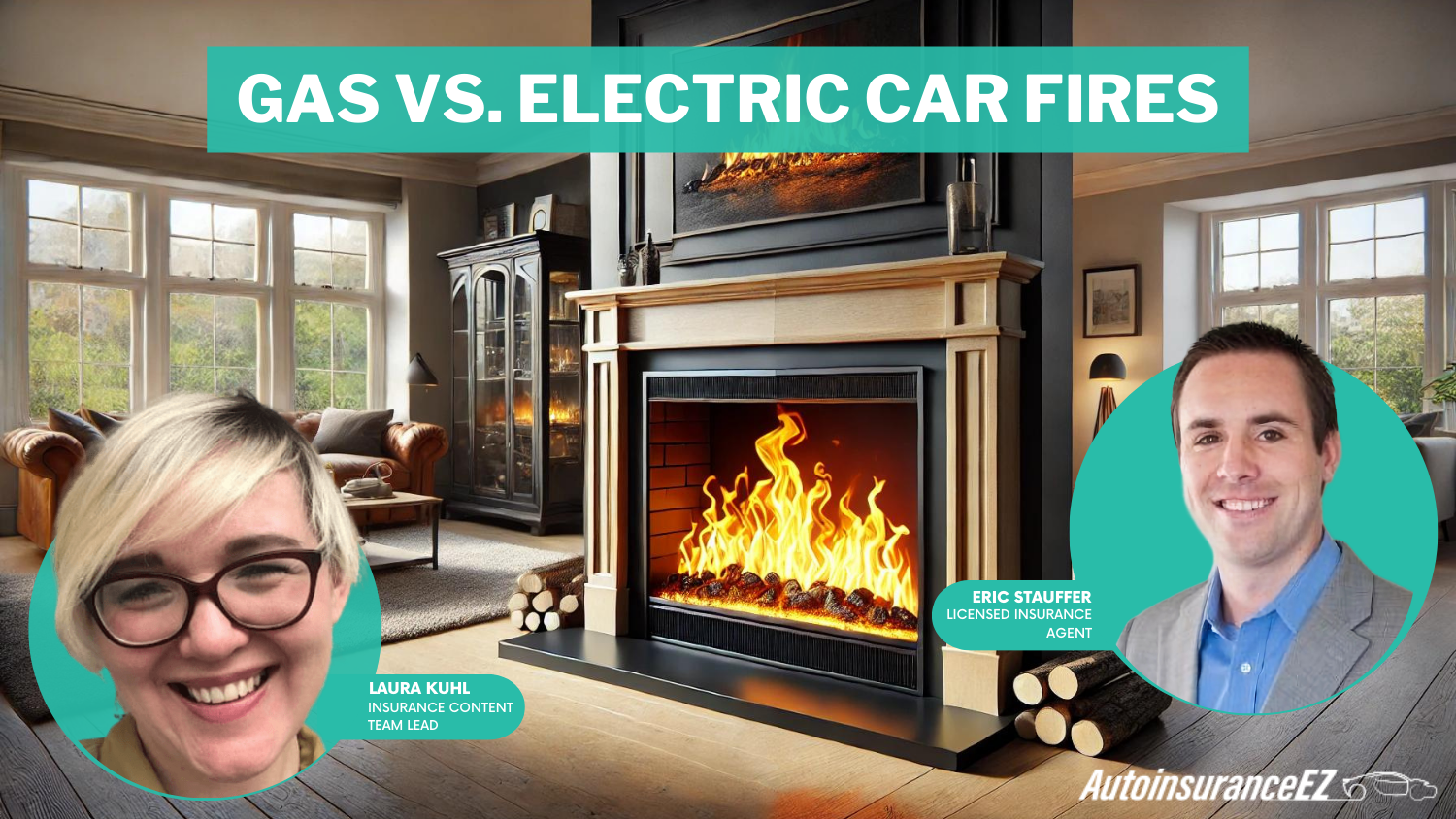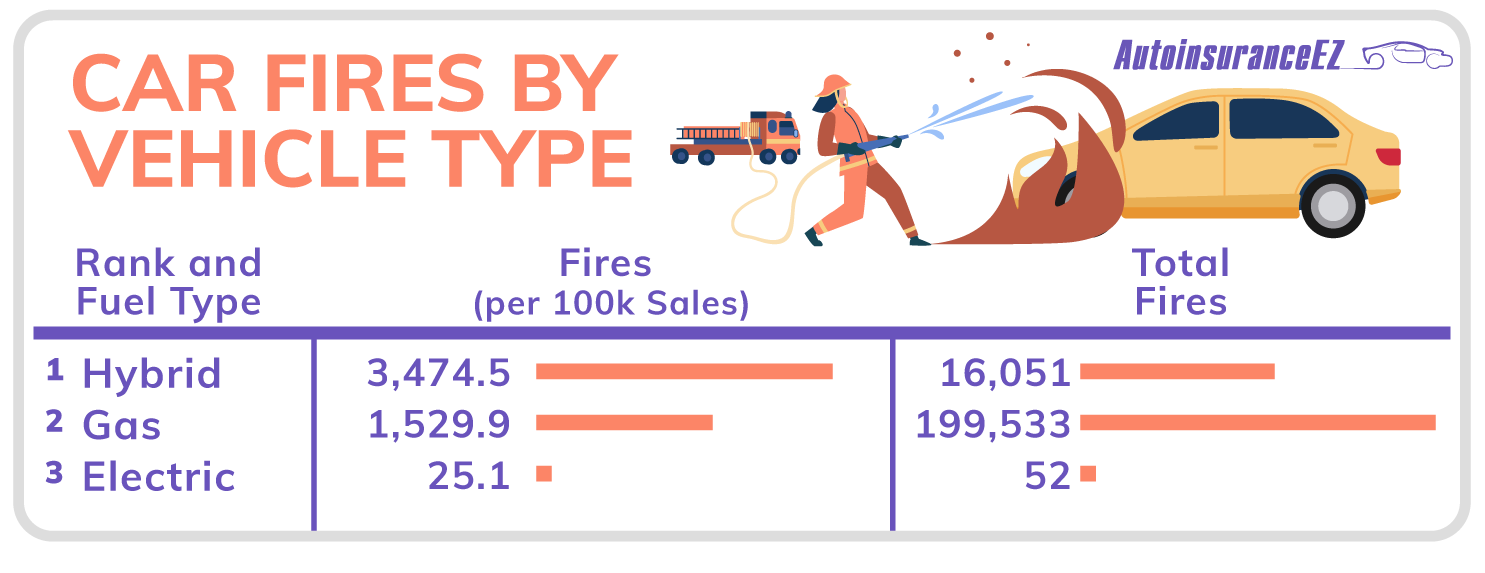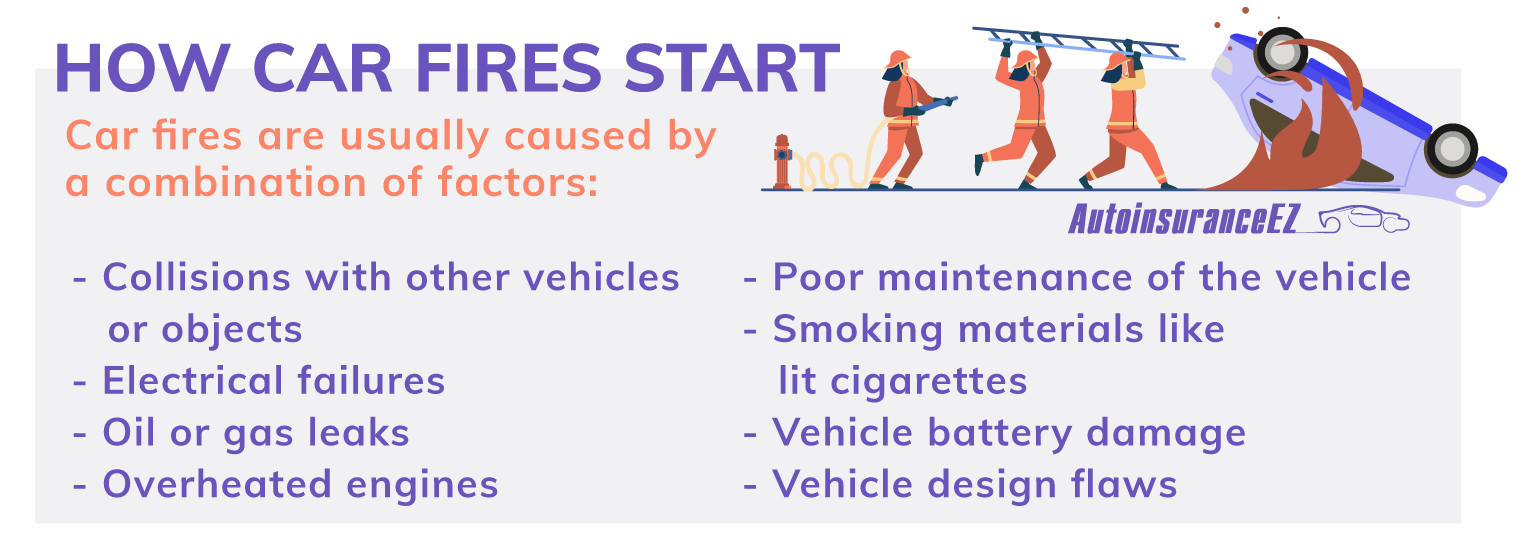Gas vs. Electric Car Fires in 2025 (Shocking Stats)
Gas vs. electric car fires can significantly impact your insurance rates, with monthly premiums ranging from $100 to $300 depending on your vehicle type. Understanding the causes of vehicle fires helps in choosing the right coverage, but you shoudl review your policy to ensure adequate fire damage protection.

Free Auto Insurance Comparison
Compare Quotes From Top Companies and Save
Secured with SHA-256 Encryption
Eric Stauffer
Licensed Insurance Agent
Eric Stauffer is an insurance agent and banker-turned-consumer advocate. His priority is educating individuals and families about the different types of insurance coverage. He is passionate about helping consumers find the best coverage for their budgets and personal needs. Eric is the CEO of C Street Media, a full-service marketing firm and the co-founder of ProperCents.com, a financial educat...
Licensed Insurance Agent
UPDATED: Sep 6, 2024
It’s all about you. We want to help you make the right coverage choices.
Advertiser Disclosure: We strive to help you make confident insurance decisions. Comparison shopping should be easy. We partner with top insurance providers. This doesn’t influence our content. Our opinions are our own.
Editorial Guidelines: We are a free online resource for anyone interested in learning more about auto insurance. Our goal is to be an objective, third-party resource for everything auto insurance related. We update our site regularly, and all content is reviewed by auto insurance experts.
UPDATED: Sep 6, 2024
It’s all about you. We want to help you make the right coverage choices.
Advertiser Disclosure: We strive to help you make confident insurance decisions. Comparison shopping should be easy. We partner with top insurance providers. This doesn’t influence our content. Our opinions are our own.
On This Page
Monthly rates for gas cars average $120, while electric car fires impact rates at around $100. When comparing gas vs. electric car fires, it’s crucial to consider factors like car fires statistics, including the electric car fire rate and gas car fires per year. Despite a lower frequency of electric car fires, their repair costs are higher compared to the more common gas car fires.
Recent reports about Tesla fires have sparked concerns regarding the fire risk of electric cars. Are Tesla batteries prone to catching fire? Despite claims from electric vehicle manufacturers that their cars are as safe as traditional gasoline-powered vehicles, we analyzed the data to determine if electric vehicles are indeed more susceptible to fires.
These sections cover handling car fires, insurance for fire damage, and comparing risks between electric and gas vehicles. Check your policy for fire coverage and use our quote tool by entering your ZIP code.
- Electric cars have a higher fire risk compared to gas vehicles
- Key causes of car fires vary between electric and gas models
- Monthly insurance rates for fire coverage average $120
Statistics for Gasoline vs. Electric Car Fires
Are electric cars more likely to catch fire? To determine whether gas or electric cars are at a greater risk of catching fire, our team of researchers dived into data from the National Transportation Safety Board (NTSB), Bureau of Transportation Statistics (BTS), and government recall data from Recalls.gov.
Below is what our researchers found for electric car fire statistics and recalls by vehicle type.
Fires by Vehicle Type
Gas vehicles are more likely to catch fire after a collision than electric ones, partly because gas cars are more prevalent on the roads. According to electrical fires statistics, the lower number of electric vehicles reduces the likelihood of such fires, despite the higher electric car fire temperature.
However, this doesn’t necessarily mean that electric vehicles are less likely to catch fire.
To find the rate of car fires by vehicle type, we collected the latest data on car fires from the NTSB and calculated the rate of fires from sales data from the BTS. Take a look at what we found below.
Hybrid vehicles actually come in number one with the most fires per 100K sales. Gas vehicles are second, and electric vehicles place third, with only 25 fires per 100K electric vehicle sales.
According to this data, electric vehicles catch fire far less often than reported in the news. Hybrid cars appear to have the highest fire risk, followed by gasoline vehicles. For those considering an electric vehicle, reviewing the 10 Best States to Own an Electric Vehicle might also be beneficial.
Fire Recalls by Vehicle Type
While the number of fires by vehicle type shows electric vehicles don’t catch fire that often, we wanted to dig a little deeper into fire hazards with electric vehicles and look at recalls. Our team of researchers collected data on the latest recalls from 2020 that involved recalls for fire hazards. The results for the car fire recalls are below.
Both hybrid and electric vehicle recalls were all related to battery issues. This is a stark difference from the gas recalls, which were recalled for issues with fuel leaks, electrical shorts, and anti-lock braking systems (ABS).
Based on this, in EV and hybrid vehicles, it seems to be mostly battery issues that can lead to fires, rather than electrical wiring issues. Regardless of the vehicle type, a car fire is dangerous.
Just how dangerous is a car fire? According to the National Fire Prevention Association (NFPA), an estimated 560 people died in 2018 from car fires, with the majority of these fatal fires caused by collisions. Car fires also caused an estimated $1.9 billion in property damage losses in the U.S.
Enter your ZIP code below to compare auto insurance rates.
Secured with SHA-256 Encryption
The Difficulty of Putting Out Electric Car Fires
Although electric car fires are less frequent than gas fires, they are not any less hazardous, according to electric car fires statistics and Tesla battery fire statistics.
Lithium-ion battery fires in electric cars are notably more difficult to extinguish compared to gasoline fires, and many firefighters lack experience with EV fires due to the newer technology. However, in states that are favorable for electric vehicles, firefighters are more likely to be experienced in handling these fires. If you’re curious about what are common problems with electric cars, this is an important consideration.
Because EV batteries are essentially their own fuel source, they can burn for hours and be extremely difficult for firefighters to cool down.
Even when an EV fire appears to be out, it can reignite, which is why it’s so important for firefighters to be trained in putting out fires in the new hybrid and electric vehicles that are being manufactured.
“Electric automobiles catch fire less frequently than gasoline-powered cars, but the duration and intensity of the fires can make them considerably more difficult to put out due to the use of lithium-ion battery packs. Lithium-ion batteries are notoriously difficult to keep cool. Even after appearing to be turned off for 24 hours, the batteries can generate enough heat to re-ignite.”
– Axel Hernborg, CEO of Tripplo.
What causes a car to catch fire? While a fire can be caused by just one thing, like a battery explosion, it is more likely that a number of factors led to the fire.
Take a look at the graphic below to see some of the main causes of car fires.
In older vehicles, the wiring and batteries start to break down, putting them more at risk of catching fire in an accident. Since most electric vehicles aren’t yet at the advanced age of older gas vehicles, there currently isn’t any data showing if they will be at a higher risk of battery and electric explosions as they age.
However, EV vehicles are at risk of battery fires due to overcharging and high temperatures, which is a risk gas car owners don’t have to worry about.
Insights and Tips on Car Fires
Electric car fires pose a significant risk compared to gas vehicles, with monthly insurance rates for fire coverage averaging $120.
Daniel Walker Licensed Insurance Agent
We’ve asked a number of car experts for their advice, from directors of GPS fleet tracking to managers of car companies. Read on to see what they have to say about staying safe from car fires.
“Electric car fires are harder to put out because the batteries can be very difficult to cool. Because of this, they can essentially ignite all by themselves because they are so hot. It can take up to an entire day for these batteries to cool down, so electric cars have to be watched for a long time to ensure they don’t catch fire again.
“While electric car fires burn longer and sometimes hotter than gas car fires, I wouldn’t necessarily say electric cars are more dangerous. They don’t catch fire at a higher rate than gas cars, so you are not at a greater risk of a fire occurring. A fire in either one of these cars is going to be extremely dangerous.
“A couple of things you can keep an eye out for are any rapid changes in fuel or oil levels, as well as any leaking oil or electrical problems. If you recently got an oil change, but notice spilled oil, that may be a risk.
“If your car catches fire, you need to cut the ignition by turning it off and get out of there immediately. Don’t waste time getting personal items out; make sure every passenger in the vehicle gets out as quickly as possible.
Go far away from the car so that you are safely distant from flames and smoke, and call 911.
“To prevent your car from being a fire hazard, make sure to look for loose wires, leaking oil, and rapid changes in fuel and oil levels. Never forget to turn your car off and take the key out of the ignition when you pump gas.”
Daivat Dholakia is the Director of Operations at Force by Mojio.
Force by Mojio provides GPS fleet tracking for small businesses.
Why are electric car fires harder to put out than gas car fires?
“Electric car fires are harder to extinguish simply because of the battery design. Gasoline fires have a single reaction, while electric car batteries can have a prolonged source of energy to fuel the fire. This makes extinguishing an electric car fire more difficult.”
What are the differences?
“The main difference is electric vehicles have lithium batteries. These batteries contain large amounts of energy which can make a fire very difficult to put out.”
In your opinion, are electric vehicles more dangerous than gas vehicles?
“With all that being said, electric vehicles are still safer than their gas engine counterparts. Tesla claims gasoline-powered cars are 11 times more likely to catch fire.”
What things should you keep an eye out for in your vehicle that could lead to a fire?
“Maintenance! A well-maintained vehicle will have less chance of catching fire. Checking for damage or wear and tear regularly can help prevent any incidents like a car fire from happening. Oil leaks, exposed wiring, and similar maintenance issues can increase the risk of a vehicle fire.”
What are the signs your vehicle is about to catch fire, and what should you do if your vehicle is on fire?
“You want to have preventive measures in place and have a checklist. Keep your eye out for the following:
- A sudden drop in fuel or oil levels
- Extreme changes in the temperature of your engine
- Smoke or sparks
- Leaking fluid under your car
- Fuses that pop repeatedly
- Strange smells, including burning or smoke
These can all be signs that something is wrong or about to catch fire.”
How can you make sure the vehicle you drive isn’t a high-risk vehicle for catching fire?
“You will want to ensure you have all recalls taken care of. You want to ensure the vehicle has no damage, especially near the lithium battery. Watch for red flags with charging issues, such as your battery not holding a charge or draining faster than normal.”
Do you have any personal experiences with car fires?
“Thankfully, no. I do keep a fire safety kit just in case, though.”
Ross Sparks is the Editor-in-Chief at TheSolarAdvantage.net.
His team provides RV solar product reviews and DIY guides.
What are the reports of Tesla electric car fires?
“What are the reports of Tesla electric car fires? The automaker has been hit with a series of fires in its cars, raising questions about the safety of its vehicles.
So far, there have been five reported fires in Teslas, including one that killed two people in California. Investigations into all of the incidents are ongoing.
While each fire is unique and must be looked at individually, some experts believe that there may be a link between the fires and how lithium-ion batteries are designed. Tesla has released a statement saying that it is working to improve the safety of its vehicles.”
Tesla claims that the Tesla problems with fires are rare, but while it is unusual for the cars to catch fire while simply charging in the garage, it has happened.
What could be causing these fires?
“It is unknown what could be causing these fires, but they may result from a mechanical failure or a faulty fuel system. In each of the five cases, the gasoline-powered cars spontaneously caught on fire after driving for a short distance.
Firefighters quickly extinguished the fires, but it is possible that had the cars been in traffic, they could have caused significant injuries or even fatalities. Some experts have suggested that the batteries in these cars may be defective and could be a source of the fire.
Tesla has released a statement saying that it is working to improve the safety of its vehicles, but it is not clear what steps the automaker is taking to investigate or fix the issue.”
How would you feel if your Tesla caught on fire?
“I wouldn’t feel too great about it if my Tesla spontaneously caught on fire. Luckily, I’ve never had that happen to me, but it’s always worrisome to think about. I guess the biggest concern would be the potential for injury if the car were in motion. And of course, any damage to the car would be a big inconvenience.”
Melanie Cohen is the co-founder of Instya.com.
Her company provides auto part info and listings.
“The media is reporting on a new study that suggests that electric car fires are more common than previously believed.”
What does the study say?
“Electric cars are considered less likely to start fires, but this is not always the case. A study by the University of Tennessee found that electric car fires are more common than those in gasoline cars.”
What are the findings of the study?
“The study found that electric car fires occur in 3 out of every 1,000 starts, while gas car fires occur in 1 out of every 10,000 starts.
Electric cars are generally considered to be safer than gas cars, as they do not produce emissions that can endanger people. However, a recent study has found that electric car fires are more common than previously thought.
The study, which was conducted by researchers at the University of California-Irvine, found that electric car fires are responsible for approximately one-third of all car fires in the United States.
This is significant because electric cars make up a relatively small percentage of the overall vehicle market.”
What should we make of the news?
“The recent news of electric car fires is causing concern, especially given that gas cars account for the majority of vehicular fires. What should we make of these events?
There are a few things to consider when looking at these electric car fires. First, it is important to remember that these are still relatively new technologies and there will likely be some growing pains as companies refine their designs and manufacturing processes.
Second, it’s important to note that these types of fires are typically caused by malfunctioning batteries or electrical components, not necessarily by gas leaks or other mechanical problems with the car itself.
Finally, it’s worth noting that electric cars still have a long way to go before they can fully replace traditional gasoline-powered vehicles.
The news that electric car fires are more common than previously believed is generating a lot of buzz. While the findings of the study should be taken with a grain of salt, it is important to be aware of the potential dangers of these cars.”
Lianzhen Yang is the CEO of Pala Leather.
His company sells custom-made clothing.
What causes electric car fires?
“There have been a number of electric car fires recently. Some of these fires have been serious, while others have been minor.
Electric cars are becoming more and more popular, but they do have one downside: they tend to be safer than gas cars, but they can also be more dangerous if something goes wrong. One of the things that can go wrong is an electric car fire.
Gas car fires are caused by a number of different things, but electric car fires are typically caused by a problem with the battery. If there’s a problem with the battery, it can overheat and start a fire. Electric car fires also happen more often when the battery is cold, which is because when the battery is cold it has less power.”
How dangerous are electric car fires?
“Electric cars are becoming more and more popular, as they are seen as environmentally friendly. However, this also means that electric car fires are becoming more common. Electric car fires can be dangerous both for the drivers and the bystanders.
Electric car fires can be caused by a number of different things, such as a short in the wiring or a faulty battery. In either case, electric current will flow through the car’s wiring and cause an explosion. This means that electric car fires can be extremely dangerous both for the drivers and the bystanders.”
What can you do to prevent electric car fires?
“Electric cars are becoming increasingly popular, with many people believing that they are more environmentally friendly than gas-powered vehicles. However, there is one potential downside to electric cars – they can be prone to fire.
When an electric car battery fires, it produces heat that can cause the car’s insulation and wiring to heat up and start burning. In fact, electric car fires are a serious issue in 2015, they caused over 100 injuries and seven fatalities worldwide.
The good news is that you can take steps to prevent electric car fires from happening in the first place.
- Make sure your battery is properly installed and connected – if it’s not properly installed or connected, the battery could begin to fire even when the car is off.
- Keep your electrical cords tidy – if cords are Tangled or Sprawled out across the floor, they could become entangled in your car’s wiring and start a fire.
Electric car fires are a serious issue. They can be dangerous and cause a lot of damage. It is important to take precautions to prevent them from happening. If you do have an electric car fire, it is important to get it extinguished as quickly as possible.”
James Brooks is the CEO of CostumesHeaven.com.
His company provides custom-made costumes and apparel.
What is the difference between a gas and electric car fire?
“A recent study has shown that gas vs. electric car fires is similar. A gas car fire is typically caused by a leak in the fuel system, while an electric car fire can be due to a problem with the battery or charging system. In either case, the heat from the fire can cause severe damage to both the car and its occupants.”
What is the same between a gas and electric car fire?
“A few things are generally the same between a gas and electric car fire. First and foremost, both types of fires can be caused by faulty wiring or components in the car.
This can lead to an electric current running through the car’s battery, which can start a fire. Additionally, both types of fires can be challenging and may require extensive damage control to prevent them from spreading.”
How do gas and electric car fires affect the environment?
“There are many factors to consider when discussing the environmental impact of gas and electric car fires. The type of fuel used, the distance the fire travels, and how much waste is produced are just a few considerations.
Both gasoline and electric cars produce emissions when they’re in use. Gasoline cars release pollutants through the exhaust pipe, while electric cars generate emissions from the battery. Emissions from both types of vehicles can contribute to air pollution and climate change. Car fires also create hazardous materials that must be dealt with effectively.
When a gas or electric car fire reaches high temperatures, volatile chemicals can be released into the air. These chemicals can cause respiratory problems and other health hazards if breathed in a concentrated form.
Based on this study, it appears that gas and electric car fires are pretty similar. However, it is still essential to understand the risks of owning a gas or electric car.”
Anup Kayastha is the owner of AutoLoanCalculator.net.
He studies user error and vehicle defects that increase interest rates.
What is the difference between a gas and an electric car fire?
“When it comes to car fires, there are two main types: gas and electric. Gas car fires are typically caused by fuel leaks or engine problems, while battery issues usually cause electric car fires.
Gasoline car fires typically start in the engine compartment, where the fuel tank and engine are located. The most common cause of these fires is a fuel leak, which can be caused by a number of factors, including a faulty fuel line or a cracked fuel tank. Engine problems can also lead to gasoline car fires, such as an oil leak that ignites the hot engine.
Electric car fires usually start in the battery compartment, where the battery and electrical components are located. The most common cause of these fires is an electrical short circuit, which can be caused by damaged wiring or a defective battery cell.
Battery overheating can also cause an electric car fire if the cooling system fails to keep the battery at a safe temperature.”
What is the same between a gas and electric car fire?
“There are some similarities between gas and electric car fires. Both fires typically start in the engine or battery compartment, where the relevant components are located. In both cases, a fuel leak or electrical short circuit is the most common cause of the fire. However, there are some key differences between the two types of fires.
Gasoline car fires are more likely to be caused by engine problems, while electric car fires are more likely to be caused by battery issues. Gas car fires also start in the engine compartment, while electric car fires usually start in the battery compartment.”
How do gas and electric car fires affect the environment?
“Car fires can significantly impact the environment, depending on the type of fire and the materials involved. Gasoline car fires typically release harmful chemicals into the air, including carbon monoxide and other pollutants.
Electric car fires can also release harmful chemicals, but they are less likely to do so than gasoline car fires. Additionally, electric car fires often involve lithium-ion batteries, which can release toxic fumes when they burn.”
Micheal Berry is the CEO of ILoveMiniVans.com.
His site provides vehicle safety tips and comparison guides.
“Gasoline/petrol is a hydrocarbon liquid that vaporizes at a relatively low temperature. Hence, when you pour it over an open flame, the vapors from the liquid-gas ignite and burn quickly and go out easily. It causes rapid combustion, but the fire burns itself out quickly.
The vaporized hydrocarbons are more volatile than butane and other fossil fuels, so they’re suitable for starting campfires or barbecuing meat. This is why we use gasoline for fire starting.
As for electric vehicles, gasoline/petrol cars benefit from a stored energy source—petrol at the gas station.
The electric vehicle has no stored energy source, so it will catch fire if it’s left for a long time with the battery drained.
Fire hazard is always present in an electric car. Electric cars can also short circuit by touching each other through high voltage connections that are not designed to handle both positive and negative voltages simultaneously.
Yes, there are many fire hazards involved in electric vehicles. There is the risk of battery fire, which is worse than that of a gas car, and there is also the risk of electrocution from faulty wiring. Electric vehicles are much more likely to catch fire than gas cars.
The average person doesn’t need to worry about the risk, especially if they are not driving an electric car or working on it. The risk for the average person is close to zero. But if you’re the owner of an electric vehicle or working on it, you need to worry about this risk.”
Katherine Brown is the founder of Spyic.
Spyic offers a remote monitoring app for parents.
“EV fires are tougher to extinguish than traditional fuel-related fires due to the battery source itself. A lithium-ion battery creates an electro-chemical fire, whereas a petroleum fire is purely organic. Electrochemical fires are hotter, contain more energy, and can reignite if proper suppression methods aren’t used.
EVs are still new. So when something goes wrong, they become the center of attention. However, according to a recent NHTSA study, EVs are at a much lower risk of incidence by a factor of about 50%. From another perspective, there are fewer moving parts in an EV, and energy conversion doesn’t involve combustion which also makes them safer.
Where there’s smoke, there’s fire. And usually, before smoke, there is an odd smell. Whether you drive a traditional fuel vehicle or an EV, keep your senses tuned to smells in the cabin, especially harsh or acrid ones coming from the vents.
Additionally, you can detect the first signs of a fuel leak after you park your car after a long drive. If you pass by the engine compartment when you shut down, and you can smell fuel, it’s because fuel vapor is escaping somehow. This easily fixable issue is often ignored for days, weeks, or months.
If your vehicle catches fire, do not panic. You will always have a sign, whether audible, visual, olfactory, or all of the above. When you have a sign, you’ve got at least a few seconds. And seconds can make all the difference.
If you are on the freeway or surface streets, target your “out.” see if there is a place that you can easily maneuver to that gets your vehicle out of other people’s way while also giving you room to evacuate safely.
Have a plan. Thinking about a situation like this ahead of time can also save your life. Are there kids in the car? Car seats? Child safety locks? Other passengers? Pets? Help yourself first, then kids, passengers, then pets. Never reach for belongings.
Numerous tools exist online and at auto parts stores that can help you slice through seat belts and break the shatter-proof glass. They are inexpensive. You can mount them discreetly where you can easily reach them. They can be the difference between your being trapped or surviving.
Onboard fire suppression. Small fire extinguishers exist to help you with this too. If small flames enter the cabin from vents or floorboards, these mini extinguishers carry enough suppression to help you get out before things reignite.
You will never be able to extinguish a car fire. Your role is to evacuate safely and get as much distance from the vehicle as you can while seeking help.
The best thing you can do in terms of prevention is to make sure that you care for your vehicle properly. Don’t ignore warning signs like overdue service, fuel, or chemical-like smells. If your vehicle is newer and needs software updates from time to time, be sure to get them and understand what those updates are for.
In many cases, these software updates are designed to create efficiencies that lower battery temperatures.
In the 20 years that I spent working on vehicles, I only had one instance of fire in my shop. After a complete air-conditioning overhaul on a vintage SUV, I heard an odd sound coming from the compressor while I was doing post-repair tests and checks. I immediately went to shut the vehicle down.
When I went back to the engine compartment, I noticed one of the AC hoses had an enormous bulge in it. I was running for my fire suppression kit when I heard the hose rupture and flames ignite. Fortunately, I knew this was coming from the signs I saw and was back to the vehicle with the proper suppression kit in seconds.
The vehicle suffered no damage other than the faulty AC components. New parts were ordered, reinstalled, and the vehicle was left as good as new.
If you visit a junkyard in any city or town, you’ll be able to walk through the vehicles and will undoubtedly see car fires, some severe, some moderate. Car-fire vehicles account for a handful of the hundreds of other vehicles that are in there. In other words, car fires are rare. But they do happen. And now you know how to be prepared no matter what type of car you drive.”
Lance Willis is the general manager of Bayway Volvo Cars.
His company provides auto service and sells pre-owned cars.
Researching Auto Fires by Type
To discover how many electric cars catch fire every year and are recalled for fire risks compared to gas vehicles, our team pulled data from the following sources:
- National Transportation Safety Board (NTSB)
- Bureau of Transportation Statistics (BTS)
- Recalls.gov
Using NTSB data on fires, our researchers calculated the rate of fires per 100K sales for hybrid, gas, and electric vehicles using sales data from the BTS. This allowed them to see if electric vehicles were actually catching fire at a greater rate than other vehicles.
To round out the investigation, our researchers also pulled data from 2020 on from Recalls.gov to find which vehicles were recalled as fire hazard risks.
Our researchers discovered that, despite the media’s emphasis on EV fires, electric vehicles are not inherently more dangerous than gas or hybrid cars. However, fires in electric vehicles are generally more challenging to extinguish compared to those in gas-powered vehicles. This finding highlights the importance of reviewing Electric Auto Insurance options for adequate coverage.
Whatever you drive, make sure you familiarize yourself with safety protocol for car fires to keep yourself and others safe on the road.
Now, are you ready to save money on your auto insurance and make sure you are protected from car fires? Enter your ZIP code into our free auto insurance comparison tool to get started today.
Enter your ZIP code below to compare auto insurance rates.
Secured with SHA-256 Encryption
Frequently Asked Questions
How common are vehicle fires?
According to the NFPA, vehicle fires account for roughly 16% of reported fires. It is rare for a vehicle to catch fire just sitting in a garage; it is more common for vehicles to catch fire after a crash.
Where do most vehicle fires start?
Most vehicle fires are caused by a crash. What causes a car to catch fire in an accident? Most fires originate within the vehicle, such as a broken fuel line coming into contact with an overheated engine.
Will insurance cover my car if it catches fire?
If your car caught fire from a collision, it would likely be covered under collision insurance. However, if your car caught fire from vandalism or a forest fire, it will be covered under comprehensive insurance. Comprehensive insurance isn’t mandatory, but it is a great coverage to have. Check out our “How much insurance coverage do I need?” to understand coverage essentials.
How do you put out a car fire?
It is best to avoid trying to put the fire out yourself. Instead, simply get out of the vehicle and move a safe distance away in case of an explosion. Call for help and let the professionals handle it, especially if it is an electric vehicle fire.
What cars catch fire the most?
Based on our study results, hybrid vehicles have the most vehicle fires per 100K vehicle sales, followed by gas vehicles. Electric vehicles have the fewest fires per 100K vehicle sales.
Can I sue if my car caught on fire?
If your car caught on fire in the driveway because of a manufacturer error, such as a design flaw or defective battery, you could file a lawsuit against the company. However, if your car caught fire because of an accident or lack of maintenance, you usually won’t have a case.
You may also have a case if your car caught fire in a wildfire and your insurer canceled your comprehensive insurance because you live in a wildfire area. Recently, California banned insurers from canceling homeowners insurance for customers who live in wildfire areas.
Which Tesla Model catches fire?
Some of the Teslas that have caught fire have been the Tesla Model S Plaid, Tesla Model 3, and Tesla Model X. Some of the Tesla fires were from collisions, while others were from Tesla battery issues that led to Tesla battery explosions.
Can a car burst into flames?
Yes, a car can burst into flames after damage from an accident. For example, there may be an engine fire after spilled fuel comes into contact with an overheated engine. Or a car may catch fire in a driveway due to a number of factors, such as battery defects or faulty electrical lines.
What is the biggest junkyard in Pennsylvania?
The biggest junkyard in Pennsylvania is the 1-800-GOT-JUNK? in Philadelphia. Known for its extensive inventory and efficient services, it handles a vast range of vehicle parts and scrap. Learn how to find cheap auto insurance in Pennsylvania and get affordable coverage options.
What are the statistics for car fires by fuel type?
Car fire statistics show that gasoline vehicles experience a higher number of fires compared to electric vehicles. According to recent data, gasoline cars account for about 60% of all car fires, while electric vehicles represent a much smaller percentage, around 5%.
Do hybrid cars catch fire?
Yes, hybrid cars can catch fire, although they are less prone to fires compared to traditional gasoline vehicles. The risk is associated with both the high-voltage battery and the conventional combustion engine.
How many gasoline car fires occur per year?
Each year, there are approximately 150,000 gasoline car fires reported in the United States. This figure includes both minor incidents and significant fires.
Enter your ZIP code to compare quotes instantly and find the cheapest insurance available.
Are electric cars dangerous?
Electric cars are not inherently dangerous, but they do have specific risks, such as potential battery fires, which are less frequent than gas vehicle fires. Read “What are common problems with electric cars?” to understand the typical issues electric vehicles face.
How many electric cars have caught fire while charging?
While exact numbers vary, there have been a few hundred reported cases of electric cars catching fire while charging globally. These incidents are relatively rare compared to the number of electric vehicles on the road.
What are the NTSB statistics for EV fires?
The National Transportation Safety Board (NTSB) reports that electric vehicles have a lower incidence of fires compared to gasoline vehicles, with EV fires occurring at a rate of approximately 0.03% per vehicle.
How does Liberty Mutual electric automobile insurance compare to Tesla’s coverage?
Liberty Mutual electric automobile insurance offers competitive rates and coverage options, but Tesla’s insurance is tailored specifically for its vehicles and often includes unique benefits like coverage for battery issues. Our Liberty Mutual auto insurance review points out these features.
What are the car fire statistics by brand?
Car fire statistics by brand show that some brands have higher incident rates than others, with brands like Ford and Chevrolet experiencing more frequent fire reports compared to brands like Tesla and BMW, which have lower incidences of fires.
Are fuel leaks a significant fire hazard?
Yes, fuel leaks are a significant fire hazard as they can lead to dangerous fires when exposed to heat, sparks, or open flames.
Are Teslas more likely to catch fire?
No, Teslas are not at a higher risk of catching fire compared to gas-powered vehicles. Studies indicate that Tesla vehicles have a lower rate of fire incidents. This lower risk can also impact Tesla auto insurance rates, potentially making them more favorable compared to traditional cars.
What are the statistics for EV battery fires?
EV battery fires are rare, with incidents occurring at a lower rate compared to fires in gasoline-powered vehicles. Expand your understanding with our article called “title of the article.”
What do Carscatch reviews say?
Carscatch reviews generally highlight user satisfaction with car-buying experiences but vary based on individual experiences and specific dealerships.
Does Esurance cover windshield replacement?
Yes, Esurance typically covers windshield replacement if you have comprehensive coverage included in your auto insurance policy. Check out our Esurance auto insurance review to see why it’s essential for understanding coverage options, customer service, and overall value.
Enter your ZIP code below to compare auto insurance rates.
Secured with SHA-256 Encryption
Eric Stauffer
Licensed Insurance Agent
Eric Stauffer is an insurance agent and banker-turned-consumer advocate. His priority is educating individuals and families about the different types of insurance coverage. He is passionate about helping consumers find the best coverage for their budgets and personal needs. Eric is the CEO of C Street Media, a full-service marketing firm and the co-founder of ProperCents.com, a financial educat...
Licensed Insurance Agent
Editorial Guidelines: We are a free online resource for anyone interested in learning more about auto insurance. Our goal is to be an objective, third-party resource for everything auto insurance related. We update our site regularly, and all content is reviewed by auto insurance experts.













